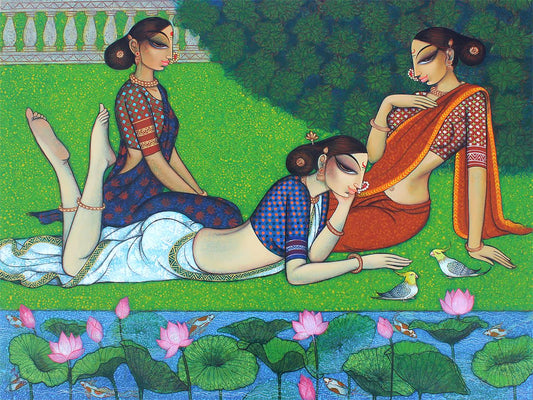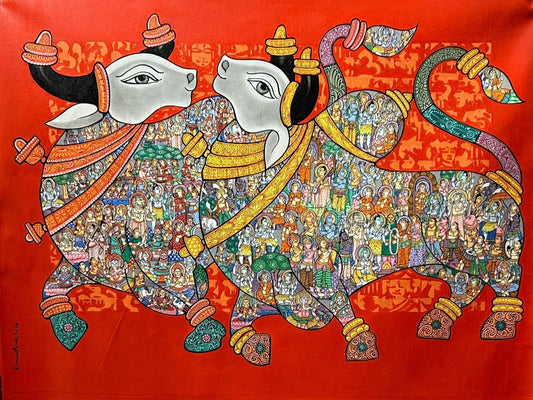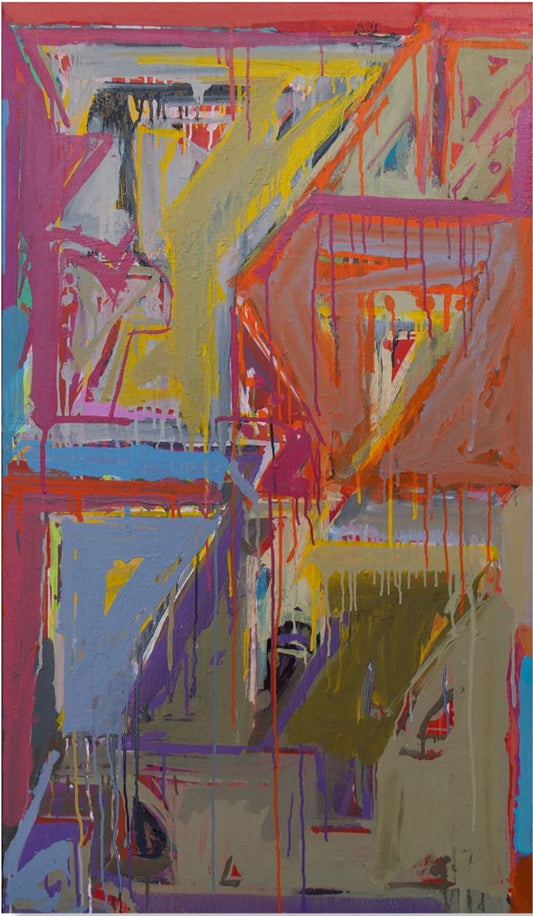A History, Origin Of figurative art paintings
Figurative art, originated around 40,000 years ago. Early works found in found in Lascaux, France, are considered as the oldest mode of artistic expression. Its historical journey unfolds across various cultures, notably in ancient Egypt where it depicted gods and pharaohs, and ancient Greece, showcasing heroes and daily life. In the Middle Ages, figurative art found its place in religious scenes, particularly narratives related to Christ.
The Renaissance marked a transformative era for figurative art, witnessing unparalleled sophistication in works by masters such as Leonardo da Vinci, Michelangelo, and Raphael. This period emphasized realism, perspective, and the human form, propelling figurative art to new heights. Post-Renaissance, it continued to evolve as a dynamic and enduring form of artistic expression. Today, contemporary artists harness figure artwork to communicate diverse ideas, emotions, and experiences, ensuring its continued relevance in the artistic landscape.
Shop A Range of Beauty in figurative art Paintings
Eikowa is an online art gallery that showcases various Indian figure artists, along with traditional art, abstract, and cityscapes. We offer a variety of figurative art to buy online, including realism, mythology and story telling, ancient history and religious paintings, still life, landscapes, conceptual paintings etc. You can buy human figures by artists such as Sukanta Das, Varsha Kharatmal, Anand Panchal, Deepa Hekre and Douglas John. Basuki Dasgupta, G Subramian, Ramchandra Kharatmal, Gurmeet Marwah and Gourishankar Soni are some of our most famous mixed media figurative artists.
Explore Original figurative Artwork Online by Best Indian Artists
Eikowa offers a variety of Indian figurative art in various forms. Ritu Kamath, Sanjay Devsale, Roy John, are some of our most popular landscape artists. Renowned artists with animals as their subjects, Dinkar Jadhav, Devidas Dharmadhikari, Gurmeet Marwah, HR Das, Vivek Kumawat showcase their paintings of horses, bulls and other animals on our website. We also have stylised figure paintings by Jagannath Paul, Thota Vaikuntam, Shyamal Mukherjee, Sachin Sagare, Ramchandra Kharatmal, etc. Amit Bhar is famous of his realistic Banaras cityscapes and Suraj Kumar Kashi, and Zakir Husain Tanha’s paintings would remind one of surrealistic paintings. Ramesh Gorjala, Vivek Kumavat, Om Swami, Basuki Dasgupta, G Subramanian, Anasuya Bommanaboina are well known for their religious figurative paintings.
What Are The Base Material Use In figurative Art Paintings
Figurative painting offers a broad spectrum of materials and techniques, providing artists with the means to craft varied and expressive artworks. While the specific materials employed can vary based on an artist's style and preferences, several common elements include:
Paint: Serving as the primary medium, artists utilize various types such as oil, acrylic, watercolour, and tempera. Each paint variant presents distinct properties influencing factors like drying time, blending capabilities, and opacity, shaping the artist's approach and the overall visual impact.
Drawing Media: Charcoal, graphite, and pastels are frequently utilized for preliminary sketches and studies, allowing artists to explore forms, proportions, and compositions in a spontaneous and direct manner before applying paint.
Surfaces: Figurative paintings find their canvas on diverse surfaces like canvas, wood panels, paper, and even unconventional choices like fabric or found objects. Surface selection affects texture, durability, and the overall aesthetic.
Brushes: Essential tools for applying paint and creating diverse textures and marks, brushes come in varying sizes, shapes, and stiffness to achieve desired effects.
Other Materials: Beyond core elements, artists may incorporate additional materials such as collage elements, found objects, fabrics, and even digital components, allowing for experimentation and the creation of unique mixed-media artworks.
Explanation of the different themes and styles available
Figurative painting encapsulates a diverse array of themes that mirror the myriad perspectives, experiences, and emotions embedded in the work of artists throughout history. Here's an insight into some noteworthy themes explored within figurative art:
Humanity and the Human Condition: Figurative art serves as a powerful medium for capturing the essence of human existence, delving into the spectrum of emotions, experiences, and relationships. Artists navigate themes like love, loss, joy, sorrow, conflict, and resilience, portraying the intricate tapestry of human interactions.
Mythology and Storytelling: Acting as a visual narrative, figure art draws inspiration from mythology, folklore, and literature. Artists breathe life into legendary figures, mythical creatures, and fantastical scenes, weaving tales of heroism, adventure, and the supernatural.
Historical Events and Social Commentary: Figurative art documents historical moments, social upheavals, and political struggles. Artists act as witnesses to their times, employing their brushstrokes to comment on social injustice, political turmoil, and the transformative potential of collective action.
Portraiture and Individual Expression: Figurative art plays a crucial role in capturing individual portraits, preserving the likenesses of historical figures, influential personalities, and ordinary individuals. Artists delve into the intricacies of human character, portraying the unique essence of subjects through expressions, gestures, and personal attributes.
Still Life and Everyday Objects: Figurative art extends to the depiction of everyday objects, elevating the mundane to artistic realms. Artists transform still lives into compositions of beauty and contemplation, infusing ordinary objects with meaning and significance.
Nature and the Natural World: Drawing inspiration from nature's beauty and power, figurative art captures landscapes, flora, fauna, and the human connection with the natural world. Artists portray the grandeur of mountains, the tranquility of forests, and the delicate details of plants and animals.
The Divine and the Spiritual: Figurative artwork plays a significant role in religious and spiritual expression, portraying deities, sacred figures, and scenes from religious narratives. Artists aim to capture the essence of the divine, conveying reverence, awe, and the human connection to the spiritual realm.
These themes provide just a glimpse into the expansive and multifaceted realm of figurative art. Artists continuously push boundaries, exploring new perspectives, and challenging traditional notions of representation, ensuring that figurative art remains a dynamic and expressive force in the art world.
The art of representing identifiable subjects, known as figurative painting, has undergone a dynamic evolution across various styles, each encapsulating the artistic essence of its era and the varied viewpoints of its originators. Let's delve into some of the noteworthy styles that have made a lasting impact on the realm of art.
Renaissance: Masterpieces from the Renaissance, spanning the 14th to the 16th centuries, epitomized realism, perspective, and humanist ideals. Visionaries such as Leonardo da Vinci, Michelangelo, and Raphael breathed life into biblical scenes, historical tales, and portraits with unparalleled precision, embodying the intricacies of human anatomy and emotion. These artists demonstrated a profound mastery of light, shadow, and perspective, infusing their works with a captivating sense of depth and realism that held viewers spellbound.
Baroque: Dominant in the 17th century, Baroque painting distinguished itself through its dramatic flair, intensity, and the application of chiaroscuro – a striking use of light and shadow. Pioneers such as Caravaggio, Rembrandt, and Peter Paul Rubens utilized vivid contrasts, expressive brushwork, and theatrical compositions to evoke grandeur, emotion, and spiritual fervor. Frequently portraying religious scenes, historical events, and mythological figures, their works exuded a distinctive sense of theatricality and emotional resonance.
Realism: Originating in the mid-19th century, Realism as an art movement aimed to represent the world faithfully, emphasising honesty and precision. Renowned artists such as Gustave Courbet, Jean-François Millet, and Honoré Daumier directed their focus toward ordinary scenes, societal concerns, and the working class, portraying life's realities devoid of embellishment or idealization. Their works were intent on mirroring the social and political landscape of their era, frequently depicting scenes of poverty, labor, and adversity.
Impressionism: Impressionism, a notable artistic movement of the late 19th century, centered around capturing the transient nuances of light and colour. Pioneering artists such as Claude Monet, Pierre-Auguste Renoir, and Edgar Degas practiced en plein air painting, employing loose brushstrokes and vivid colour palettes to encapsulate the immediacy of a moment, the dance of light and shadow, and the liveliness of city existence. Frequently portraying ordinary scenes, landscapes, and portraits, their creations were infused with a feeling of spontaneity and atmospheric realism.
Post-Impressionism: Post-Impressionism, an artistic movement that surfaced in the late 19th century, expanded upon the principles of Impressionism by delving into more subjective and expressive methodologies. Visionaries such as Vincent van Gogh, Paul Cézanne, and Paul Gauguin maintained a focus on light, colour, and form but ventured into bolder brushwork, distorted perspectives, and symbolic elements. Their creations mirrored a profound exploration of personal emotions, artistic expression, and the intricate dynamics between the artist and the subject.
Expressionism: Expressionism, reaching its zenith in the early 20th century, underscored emotional expression by distorting form and colour. Pioneering artists such as Edvard Munch, Ernst Ludwig Kirchner, and Wassily Kandinsky employed vibrant hues, exaggerated forms, and expressive brushwork to articulate their inner tumult, anxieties, and emotional landscapes. Frequently portraying intense emotions, psychological states, and the human condition, their creations manifested in a raw and visceral manner.
Surrealism: Surrealism, an artistic movement that prioritized the subconscious, dreams, and irrationality, surfaced in the 1920s under the leadership of prominent artists including Salvador Dalí, René Magritte, and Max Ernst. Distinguished by dreamlike imagery, unforeseen juxtapositions, and distorted perspectives, their artworks delved into the profound recesses of the human mind, the potency of dreams, and the irrational facets of existence.
Pop-Art: Pop art, a mid-20th century art movement, found its roots in popular culture and mass media. Artists such as Andy Warhol, Roy Lichtenstein, and Jasper Johns drew from advertising, comic books, and consumer products, employing vibrant colours, graphic methods, and recurring motifs. Their creations mirrored the expanding impact of mass media and popular culture, exploring themes encompassing consumerism, celebrity, and the ordinary facets of daily life.
Why Choose Eikowa For Buying figurative art paintings Online?
Eikowa stands as a dynamic platform, showcasing a multitude of artists with diverse backgrounds and regional influences. Browse and buy various figure art, alongside other genres like traditional, abstract and conceptual paintings. Our carefully curated online art gallery provides a dedicated space to admire and acquire figurative artwork and various other painting styles. Blockchain authentication, art advisory services, and worldwide shipping, are some of our most remarkable features, that enhance the buying experience for art lovers globally, making it effortless to procure Indian artwork online.





























